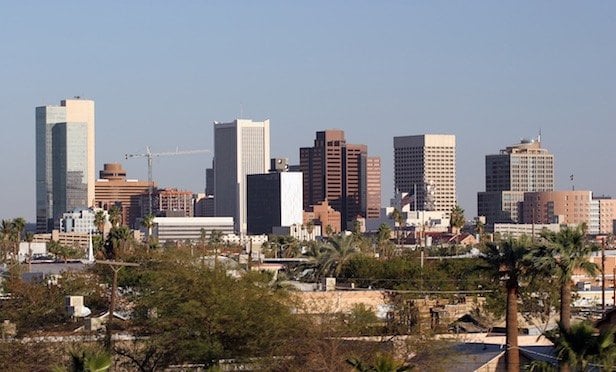 The first US/Mexico inland port is under construction in Phoenix. SkyBridge Arizona is on 360 acres southwest of the runway at Phoenix-Mesa Gateway Airport in Mesa, and will use Unified Cargo Processing to complete on-site cargo inspection and processing that will allow shipments between the U.S. and Mexico can be expedited directly to their destinations in Mexico.
The first US/Mexico inland port is under construction in Phoenix. SkyBridge Arizona is on 360 acres southwest of the runway at Phoenix-Mesa Gateway Airport in Mesa, and will use Unified Cargo Processing to complete on-site cargo inspection and processing that will allow shipments between the U.S. and Mexico can be expedited directly to their destinations in Mexico.
"This is going to be a city-within-a-city. It is going to be a mixed-use development, and the main focus is going to be an inland port," Rusty Martin, project executive at Graycor Construction Co., tells GlobeSt.com. "It is a unique situation, and it is the only one in the United States that have been approved. The idea is that Mexican customs will have a presence on the ground in the United States, and anyone that is shipping goods or product to Mexico could lease space on the property and run all goods through customs in the United States and then immediately ship it to its destination."
Graycor Construction Co. has broken ground on the first two buildings at the development. The first is an airplane hanger, and the second is a speculative flex industrial building facility that will total 50,000 square feet suitable for light industrial and warehouse use by one or two occupants. It will feature 24-foot clear height, up to four docks and storefront entries with administrative offices, conference space and break areas.. "The first two buildings aren't necessarily tied to the port concept," says Martin. "The first is a four-bay airplane hanger that is being built speculatively. The second building is a 50,000-square-foot industrial building that could be part of the port, but it is outside of the secure perimeter of the port."
The entire complex has the potential to totally disrupt the logistics market. "With this concept, the goods can fly directly into small towns in Mexico without having to first go through Mexican customs upon entry into the country," says Martin. "From a logistics standpoint, it makes a lot of sense. It is an out-of-the-box concept, but it makes a lot of sense."
In addition to the port and industrial support facilities, the mixed-use property will have other supportive asset classes. "The intent is to have large distribution customers that lease part of the property, and there will also be support businesses and hotels to support the port," says Martin.
The first two buildings will target smaller manufactures and small distribution spaces.
© Touchpoint Markets, All Rights Reserved. Request academic re-use from www.copyright.com. All other uses, submit a request to [email protected]. For more inforrmation visit Asset & Logo Licensing.






